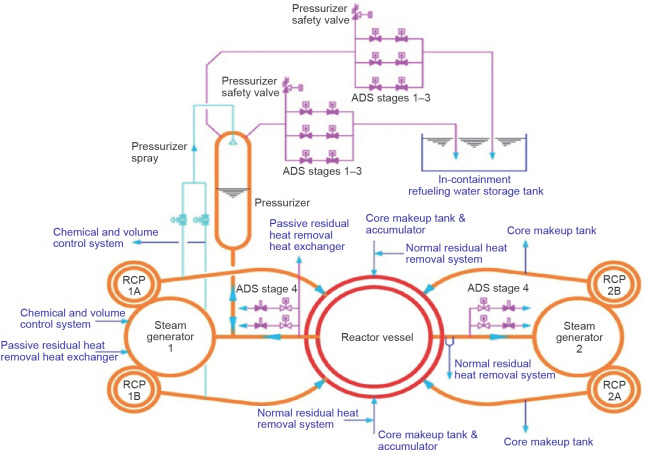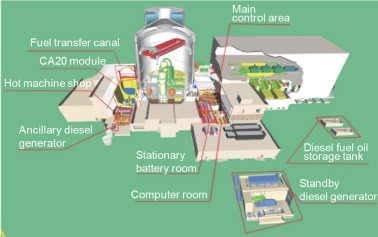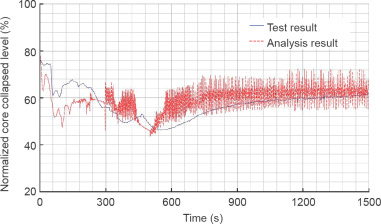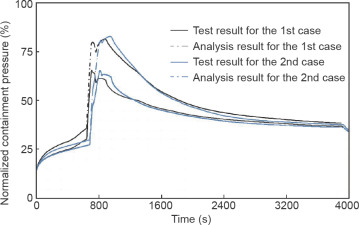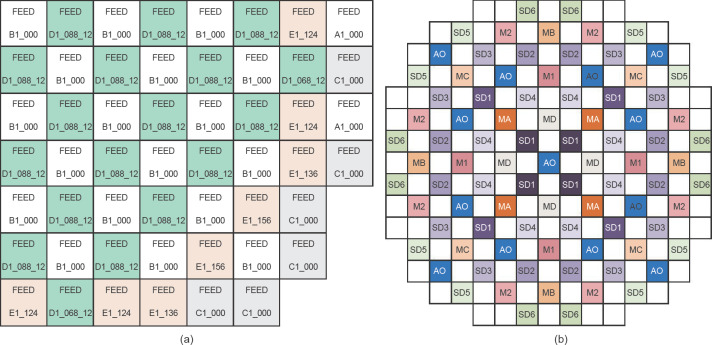ABSTRACT
The pressurized water reactor CAP1400 is one of the sixteen National Science and Technology Major Projects. Developed from Chinas nuclear R&D system and manufacturing capability, as well as AP1000 technology introduction and assimilation, CAP1400 is an advanced large passive nuclear power plant with independent intellectual property rights. By discussing the top design principle, main performance objectives, general parameters, safety design, and important improvements in safety, economy, and other advanced features, this paper reveals the technology innovation and competitiveness of CAP1400 as an internationally promising Gen-III PWR model. Moreover, the R&D of CAP1400 has greatly promoted Chinas domestic nuclear power industry from the Gen-II to the Gen-III level.
Keywords
CAP1400 ; Advanced passive technology ; General design ; Localization ; Technology innovation
1. Introduction
Engineering and societal developments, as well as an emphasis on nuclear safety, have continuously propelled nuclear technology forward, from Gen-II to Gen-III. The three historical commercial nuclear power plant (NPP) accidents (Three Mile Island, Chernobyl, and Fukushima) have promoted higher safety standards on inherited safety and probabilistic safety objectives, stricter requirements for the prevention and mitigation of severe accidents, and the implementation of the passive safety concept. Operational experiences and industrial capability improvements have brought technologies with longer lifetimes, higher burnup, higher reliability, higher availability, modularization and standardization, design simplification, and digital instrumentation and control (I&C) systems into NPPs. Concerns regarding public acceptance and environmental impact have elevated requirements for the environmental compatibility of NPPs, including the principle of “as low as reasonably achievable” (ALARA) for radiation protection and more stringent radwaste discharge standards. In 1990, the Electric Power Research Institute (EPRI) first published the Advanced Light Water Reactor Utility Requirements Document (URD) [ 1 ], which defined the basic features and minimum requirements for Gen-III nuclear power technologies through 14 key policy statements. Since then, Gen-III nuclear technologies−claimed to be safer, more economic, and more advanced−have become the mainstream of the nuclear power industry.
This paper focuses on the R&D of CAP1400, the largest Gen-III passive pressurized water reactor (PWR), including its top-tier design principles, main performance objectives, general parameters, safety design considerations, and independent design and manufacturing of key equipment; as well as on the improvements in domestic nuclear design and manufacturing capability that have been motivated by the implementation of the passive PWR series for the National Science and Technology Major Project.
2. General design and safety design
2.1. General design of CAP1400
Ensuring its advanced nature from the very beginning, CAP1400 comprehensively inherits the philosophy of the passive concept and the simplification of AP1000 [ 2 ,3 ]; follows the latest effective codes, regulations, and standards at home and abroad; complies with the technology requirements defined in the URD and other documents for Gen-III NPPs; and fully incorporates the design changes and improvements from the AP1000 units under construction both in China and abroad.
CAP1400 was developed by upgrading the power capacity level, optimizing the general parameters, balancing the entire plant design, redesigning the safety systems and key equipment, increasing the equipment localization proportion, actively responding to post-Fukushima safety policies issued by regulators at home and abroad, fulfilling the current highest safety goals, satisfying the most stringent radwaste discharge standards, and further improving the economic competitiveness. The general performance of CAP1400 reaches the worlds leading level of Gen-III technology, as shown in Table 1 .
| Parameter | Unit | Value |
|---|---|---|
| Core rated power | MWt | 4040 |
| Electric power output | MWe | ~1500, depends on site condition |
| Design lifetime | years | 60 |
| Availability | 93% | |
| Construction duration | month | ≤56 for first, 48 for fleet |
| Operator action time | h | 72 (7 days with some water supply operation) |
| Core damage frequency (CDF) | per reactor year | 4.02 × 10−7 |
| Large release frequency (LRF) | per reactor year | 5.07 × 10−8 |
| Collective occupational exposure | person Sv·(reactor year)−1 | <1 |
| Individual occupational exposure | mSv·(reactor year)−1 | <20 |
| Waste disposal standard | <1000 Bq·L−1 for coastal site,<100 Bq·L−1 for inland site, and packaged solid waste volume<50 m3 ·a−1 | |
| Safety shutdown earthquake | Safety shutdown earthquake (SSE) 0.3g (g, gravitation contant); seismic capability 0.5g | |
| Core design margin | ≥15% | |
| Fuel type | RFA modified or self-developed | |
| No. of fuel assemblies | 193 | |
| Refueling interval | month | 18 |
| Averaged discharge fuel burnup | MWd ·(tU)−1 | ≥50 000 |
| Mixed oxide fuel-loading capacity | Yes | |
| Average linear power density | W·cm−1 | 181.0 |
| Coolant average temperature | °C | 304.0 |
| System operation pressure | MPa(a) | 15.5 |
| Reactor coolant pump (RCP) | Domestic canned motor pump or wet-winding motor pump | |
| RCP flow rate | m3 ·h−1 | 21 642 |
| Steam pressure at steam generator (SG) exit | MPa(a) | 6.01 |
| Steam flow per SG | kg·s−1 | 1123.4 |
| Steal containment design pressure | MPa | 0.443, 10% margin |
Fig. 1 shows the configuration of the reactor coolant system. CAP1400 has two primary coolant loops that transfer the heat generated by the fission reaction of 235 U in the reactor core to the steam generator (SG). Each loop consists of a hot leg, two cold legs, one SG, and two canned pumps. CAP1400 has one pressurizer (PRZ) connected to one of the hot legs by a surge line.
|
|
|
Fig. 1. The CAP1400 reactor coolant system configuration. |
CAP1400 has a compact and reasonable general layout, as shown in Fig. 2 . It covers an area of only 0.164 m2 ·kW−1 , which is less than that of traditional Gen-II+ plants and AP1000. The estimated cost of the first CAP1400 project, located in Rongcheng City, Shandong Province, is about 16 000 CNY·kW−1 ($2443 USD·kW−1 ), which is quite competitive among the Gen-III NPPs. For the Nth of its kind, the cost of CAP1400 is expected to be much lower due to the learning effect, as well as to design solidification, equipment and material localization, matured modularity, and optimized project management.
|
|
|
Fig. 2. General layout of CAP1400. |
2.2. Safety design of CAP1400
The safety design of CAP1400 is a multi-level combination of active defense-in-depth systems and passive engineered safety features, and incorporates systematic measures for severe accident prevention and mitigation. In addition, 21 tests were conducted to validate the design reasonability and software applicability, including: an advanced core-cooling mechanism experiment (ACME), a containment safety verification via integral test (CERT), and a critical in-vessel retention (IVR) heat flux test.
Non-safety-grade active facilities, including a normal residual heat-removal system (RNS), a component cooling system (CCS), a service water system (SWS), and others, are defense-in-depth measures. These facilities remove the core heat under anticipated transients, which avoids unnecessary actuation of the passive systems and prevents the transients from deteriorating to accidents. Based on lessons learned from the Fukushima accident [ 4 ] and related regulator policies [ 5 ], several safety enhancements were carried out to strengthen these defense-in-depth facilities. First, the seismic resistance capability of the normal decay heat removal facilities (as called the “cooling chain”) was strengthened. Second, in order to further ensure the functioning of the decay heat removal path for the core and spent fuel 72 h after an accident initiation, seismic-resistant water source interfaces and portable diesel pumps were installed, and the designs of the emergency water source and power source were strengthened. For example, the emergency power was stored in a specific building [ 6 ].
The engineered safety systems of CAP1400 include a passive residual heat-removal system, a passive safety injection system, an automatic depressurization system, a passive containment cooling system, and so forth. These safety-grade passive facilities were designed to remove the heat from the reactor and containment under accident conditions, and to implement the emergency core cooling injection in order to prevent the core from melting down and ensure that radioactive substances remain confined within the containment. These passive systems, which comply with “single-failure” and “fail-safe” criteria, are triggered passively; that is, without relying on on-site/off-site AC power or other active equipment. They perform their intended function without an operators control or external assistance within 72 h of an accident initiation.
The passive safety injection system provides emergency core makeup water and high-concentration boron water under accident conditions such as those caused by a main steam pipeline rupture, and provides core safety injection during a loss-of-coolant accident (LOCA). The system includes high-pressure injection (by core makeup tank, CMT), intermediate pressure injection (by accumulator, ACC), low-pressure injection (by in-containment refueling water storage tank, IRWST), and long-term core flooding (by pit and recirculation of IRWST). Compared with those of AP1000, the CMT volume of CAP1400 is increased by 21% according to the reactor core power uprate ratio, the ACC volume is increased by 38% to meet the fast core flooding requirement during a LOCA, the IRWST volume is increased by 34% to meet the pit flooding level requirement, and the nominal diameter of the direct vessel injection (DVI) line is increased from DN200 (in AP1000) to DN250 (in CAP1400) to meet the injection flow requirement at a higher power level. These designs have been validated by systematic tests. Fig. 3 shows the test result and the software prediction of the core collapsed level during a double-ended direct vessel injection (DEDVI) line break accident. During such accidents, the core (collapsed) water level should be precisely predicted for safety analysis since it indicates whether or not the core is still submerged in water.
|
|
|
Fig. 3. Test result vs. software prediction of core collapsed level during DEDVI. |
The automatic depressurization system (ADS) functions to depressurize the reactor coolant system (RCS) during an accident so as to enable the safety injection and avoid core meltdown at high pressure. The first, second, and third stage valves function to provide early stage depressurization for the ACC injection (as well as for RNS commissioning), and their nominal diameters are all 50 mm larger than those of AP1000. The fourth stage valves function to provide final stage depressurization for the IRWST injection. In order to activate the gravitational injection as early as possible and satisfy the flow-rate requirement, their nominal diameters were expanded from DN350 (in AP1000) to DN450 (in CAP1400), with the discharge capacity increased by 60%.
The passive containment cooling system (PCS) removes the heat from the steel containment by water spray at the outer surface; the water flows down by gravity from a water storage tank installed on top of the shield building. The containment vessel was re-designed with a larger capacity to better confine the energy and mass release during an accident. By optimizing the containment wall thickness, the pressure-bearing capability of the steel containment was strengthened and the safety margin was enhanced. The elevated water storage tank can provide at least 72 h of continuous water flow without operator intervention. After 72 h from the accident initiation, the spray line can switch the suction interface to a recirculation pipeline, which is driven by active systems. As a demonstration of the CERT, Fig. 4 shows the containment pressure variation with time during large LOCAs from test and analysis (two test conditions). The in-containment pressure is a crucial parameter for containment cooling during LOCAs since it is closely related to the intactness and radioactive substance confinement capability of the containment.
|
|
|
Fig. 4. Containment pressure from test and analysis during large break LOCAs. |
The spent fuel pool (SFP) cooling system was also improved. In addition to conventional water level monitoring and spent fuel cooling facilities, a pool spraying sub-system and an emergency water supply pipeline were installed to ensure the cooling of spent fuels under postulated accident conditions [ 6 ].
In the case of a severe accident, the following countermeasures would be initiated: In the early stages of the accident, the ADS would function to depressurize the RCS to avoid core meltdown at high-pressure conditions. If the core melted, the IVR measure would be activated to prevent molten debris from relocating to the containment and causing further ex-vessel severe accident phenomena such as ex-vessel steam explosion and molten core-concrete interaction. Compared to AP1000, CAP1400 has an additional six passive hydrogen re-combiners inside its containment, and its power supply window for the hydrogen igniter has been prolonged. In addition, the seismic resistance capability of the hydrogen monitoring instruments and 66 hydrogen igniters was strengthened to ensure their availability in the case of an earthquake. The probability and hazards of the containment bypass were minimized by preventing the interfacing system LOCA and SG from overfilling due to heat transfer tube rupture accidents. Containment failure at a late stage could be prevented by removing the heat inside the containment by means of the PCS and implementing controllable containment venting measures.
According to the URD requirement, the core damage frequency (CDF) and the large release frequency (LRF) for Gen-III NPPs are CDF<1.0 × 10−5 and LRF<1.0 × 10−6 . These are the same as the requirements for units to be constructed in China. For the passive PWR CAP1400, the CDF and LRF are 4.02 × 10−7 and 5.07 × 10−8 , respectively, which are lower than the URD and domestic requirements. Moreover, severe accident scenarios that required an off-site emergency plan have been eliminated, which technically complies with the principle of no emergency evacuation. It can be found that CAP1400 is an advanced Gen-III NPP with superior safety performance.
3. Innovations in operation, equipment, and material
In addition to the safety margin enhancement and safety design improvements, innovations or improvements were also made in the reactor core, reactor pressure vessel (RPV), reactor internals, primary and main steam pipes, SG, waste treatment process, steam turbine process, I&C systems, plant anti-flooding layout, shielding building structure, modular design and construction, and so forth.
- An advanced fuel management strategy was applied that includes, for example, taking the low neutron leakage fuel load from the first cycle and thereby improving the neutron economy. Mixed oxide (MOX) fuel-loading capability is provided [ 7 ]. The load-following mechanism was strengthened by using mechanical shim core control, which equips the plant with stronger operational flexibility and reduces the boron water discharge during normal operation. Fig. 5 shows the core loading pattern and control rod assembly arrangement. The outmost assemblies use fuels with enrichments of 0.74 weight/percent (w/o) and 2.86 w/o, representing a low leakage loading pattern. Control rod assemblies consist of 41 regulation bundles (of rods) and 48 shutdown bundles; among the regulation bundles, MA−MD are gray rods (less poisonous) while M1/M2/AO are black rods.
|
|
|
Fig. 5. (a) Core loading pattern of the first cycle; (b) control rod assembly arrangement. |
- Equipment and components were optimized in the design in order to improve performance and reliability. The forging capability of equipment manufacturing was enhanced, and welding seams on the primary system were significantly reduced to ensure the integrity of the primary system and to simplify the in-service inspection. The main coolant pipes and the upper head of the RPV were integrally forged.
- The neutron shielding pad was eliminated, in contrast to that of AP1000; this reduces the occurrence of loose parts. In the lower plenum, a dismountable even-flow distributor was placed instead of a conventional flow skirt, optimizing the flow distribution into the core. In addition, the internal mass of the reactor was increased to facilitate the implementation of IVR and to enhance the ability to resist flow-induced vibration.
- The primary coolant pipes and the main steam pipes were optimized to reduce the flow velocity, with satisfying performance requirements as a prerequisite. This design alleviates flow-accelerated corrosion (FAC) in the process of long-term operation and enhances operation safety.
- A new SG model was developed and equipped in CAP1400 with a heat transfer area increased by 27% (compared with that of AP1000), which reduces primary loop resistance and improves secondary side performance. Testvalidated steam separators, consisting of 146 primary separators and 8 group dryers (double hook plate), were installed in the SG; these are beneficial for higher steam quality.
- The plant is designed to control the production of liquid radwaste from potential sources, including equipment, material, and operation mode. Advanced radwaste treatment technologies were also applied. For example, the liquid radwaste system (WLS) was equipped with an ion exchange sequence and a chemical coagulation process to lower the concentration of discharged radioactive liquid waste below 1000 Bq·L−1 for coastal sites and 100 Bq·L−1 for inland sites. In addition, the ventilation system was equipped with an iodine filter. All efforts were made to minimize the total amount of waste gas, waste liquid, and waste solid. Interfaces were provided to deal with future stricter environmental protection requirements.
- A self-developed long blade (the final grade blade is 1.828 m long) with a larger exhaust area was installed in the turbine to improve the turbo-generator efficiency; cold-end optimization of the turbine-generator was adopted to further optimize the plant heat efficiency.
- Integral I&C systems were adopted and human-factor engineering (HFE) was fully considered in designing the main control room. Moreover, the availability and performability of the main control room were enhanced and the human-machine interface was improved [ 6 ].
- A “dry” site design was adopted; a movable flashboard was installed between the auxiliary building and the 1E class battery compartment, which is located at a higher ground level to protect the plant from internal and external flooding.
- A steel-plate concrete structure was adopted for the shield building, which strengthens its resistance to a larger commercial airplane crash [ 8 ].
- Modular design and construction was applied to shorten construction duration and reduce total cost. It reduces the workload for on-site construction assembly, and facilitates production, transportation, and installation.
- After R&D of key equipment and bulk materials, these are now basically domestically supplied, including the heat transfer tubes of the SG and the welding materials (localization rate above 85%); this greatly reduces the plant construction cost. The localization of key equipment also lays a solid foundation for the fleet construction of CAP1400, and reduces the project schedule risk.
- HFE and the reliability design concept were made full use of in order to achieve high reliability of the power plant with low maintenance. The maintainability and accessibility were adequately considered [ 6 ]. The reliability allocation and design are to be carried out further, and the plant online safety and performance monitoring systems are under development; these measures will further improve the real safety of the plant.
4. Summary and future prospect
This paper has comprehensively discussed the general design approach, main performance objectives and parameters, safety design considerations, and important technology innovations of CAP1400 development. In terms of safety, economy, and other performance features, CAP1400 satisfies the Gen-III requirements. The research and design of CAP1400 has propelled the transformation of domestic nuclear design, testing, and equipment manufacturing capability from Gen-II to Gen-III.
In the future, improvements of the PWR lie in the following aspects: From the perspective of safety, it is necessary to identify equipment and instruments that bring the plant back to a stable and controllable state, according to the severe accident management guidelines (SAMGs). It is also necessary to demonstrate that the equipment and instruments can perform their intended functions under severe accident conditions with a reasonable level of confidence. From an economic point of view, it is valuable to enhance the simplification and standardization philosophy and to promptly incorporate feedback from the demonstration projects of Gen-III plants to follow-up units, so as to improve the constructability and modularity, shorten the construction duration, and ensure that the fleet construction cost is significantly reduced. From the perspective of operation and maintenance, it is indispensable to strengthen the load-following capability in consideration of the increase of the installed capacity of domestic nuclear power, and to facilitate intelligent equipment monitoring and performance diagnoses, which give strong support for maintenance optimization as well as for other plant activities.
As a large-scale advanced PWR design integrating innovation and re-innovation with independent intellectual property rights, CAP1400 has superior safety and economic advantages and a broad market prospect. It will strongly support Chinas nuclear power development in a safe and efficient manner and facilitate the implementation of the “go global” strategy.
Compliance with ethics guidelines
Mingguang Zheng, Jinquan Yan, Jun Shentu, Lin Tian, Xujia Wang, and Zhongming Qiu declare that they have no conflict of interest or financial conflicts to disclose.
Nomenclature
ACC- accumulator
ACME- advanced core-cooling mechanism experiment
ADS- automatic depressurization system
ALARA- as low as reasonably achievable
CCS- component cooling system
CDF- core damage frequency
CERT- containment safety verification via integral test
CMT- core makeup tank
DEDVI- double-ended direct vessel injection
DVI- direct vessel injection
EPRI- Electric Power Research Institute
FAC- flow-accelerated corrosion
HFE- human-factor engineering
I&C- instrumentation and control
IRWST- in-containment refueling water storage tank
IVR- in-vessel retention
LOCA- loss-of-coolant accident
LRF- large release frequency
MOX- mixed oxide (fuel)
NPP- nuclear power plant
PCS- passive containment cooling system
PRZ- pressurizer
PWR- pressurized water reactor
RCP- reactor coolant pump
RCS- reactor coolant system
RPV- reactor pressure vessel
RNS- normal residual heat-removal system
SAMG- severe accident management guidelines
SFP- spent fuel pool
SG- steam generator
SWS- service water system
URD- Advanced Light Water Reactor Utility Requirements Document
WLS- liquid radwaste system
References
- 1 EPRI ANT; Advanced Light Water Reactor Utility Requirements Document, revision 12, 3002000507, Electric Power Research Institute, Palo Alto (2013)
- 2 TL Schulz; Westinghouse AP1000 advanced passive plant; Nucl Eng Des, 236 (14–16) (2006), pp. 1547–1557
- 3 CG Lin; An advanced passive plant AP1000, Atomic Energy Press, Beijing (2008) Chinese.
- 4 EPRI ANT; EPRI Utility Requirements Document (URD) Fukushima lessons-learned treatment, 3002002074, Electric Power Research Institute, Palo Alto (2013)
- 5 National Nuclear Safety Administration; General technology requirements for nuclear power plants after Fukushima Accidents (trial implementation), National Nuclear Safety Administration, Beijing (2012) Chinese.
- 6 Preliminary safety analysis report of CAP1400 demonstration project, Shanghai Nuclear Engineering Research and Design Institute, Shanghai (2014 Oct)
- 7 CY Liu, GW Bi, B Yang; Preliminary study on core design with 50% MOX fuel in PWRs; Nucl Sci Eng, 35 (2) (2015), pp. 314–319 Chinese.
- 8 SJ Cheng, XW Wang, HH Ge, ZF Xia; Analysis of a large wide-body commercial plane impact on CAP1400 shield building; X Liu, A Ang (Eds.), Sustainable Development of Critical Infrastructure; 2014 May 16–18, American Society of Civil Engineers, Shanghai, China. Reston (2014), pp. 338–346
Document information
Published on 06/04/17
Licence: Other
Share this document
Keywords
claim authorship
Are you one of the authors of this document?
